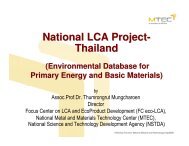ILCD Handbook: Framework and requirements for LCIA models and ...
ILCD Handbook: Framework and requirements for LCIA models and ...
ILCD Handbook: Framework and requirements for LCIA models and ...
Create successful ePaper yourself
Turn your PDF publications into a flip-book with our unique Google optimized e-Paper software.
<strong>ILCD</strong> <strong>H<strong>and</strong>book</strong>: <strong>Framework</strong> <strong>and</strong> <strong>requirements</strong> <strong>for</strong> <strong>LCIA</strong> <strong>models</strong> <strong>and</strong> indicators First edition<br />
Iwasa 2000) 16 , meaning that the population disappears from the ecosystem be<strong>for</strong>e it would<br />
have if the ecosystem had not been exposed to the stress, ―due to a reduction of the growth<br />
rate of the population. The estimated decrease in growth rate can be translated into an<br />
extinction risk, corresponding to the reduction of the MET (Hakoyama <strong>and</strong> Iwasa 2000)<br />
called MET risk (Tanaka <strong>and</strong> Nakanishi 2000). The MET model requires knowledge of the life<br />
history of the considered species, in order to assess the growth rate of the population. The<br />
population life-history data needed <strong>for</strong> estimation of the MET is the ecosystem’s carrying<br />
capacity <strong>for</strong> the population, an intrinsic growth rate <strong>for</strong> the population <strong>and</strong> its variance.<br />
Hakoyama <strong>and</strong> Iwasa demonstrate that estimation of values <strong>for</strong> these three needed<br />
population life history parameters requires a time series of population fluctuation including at<br />
least 10 data points.‖ 17<br />
This data requirement is not generally considered realistic in an <strong>LCIA</strong> context.<br />
Nevertheless, the MET approach has now been applied to <strong>LCIA</strong> in the Japanese LIME<br />
methodology 17 as a basis <strong>for</strong> deriving endpoint indicators <strong>for</strong> ecotoxicity effects - the EINES<br />
indicator (Expected Increase in Number of Extinction Species). Further study into the related<br />
simplifications <strong>and</strong> robustness of this approach is justified.<br />
3.2.4.2 Changes in genetic diversity<br />
Both approaches to the assessment of biodiversity loss described above suffer from ―a<br />
conceptual divergence from the earlier quoted Rio Convention’s definition of biodiversity‖ 17 ,<br />
quoted as including the diversity within a species reflecting the genetic variation within the<br />
population. Instead of using biodiversity as a basis <strong>for</strong> the endpoint modelling, use of ―genetic<br />
diversity could be a good alternative in solving some of the problems‖ 17 related to the<br />
divergence of concepts focusing on diversity within species, versus concepts focusing on<br />
diversity between species. This also considers the problem with vulnerability of species after<br />
repeated exposure to contaminants.<br />
“With the development of new genetic techniques, it has become possible to quantify the<br />
number of genes of some species or some loci. Genetics of ecotoxicology has become an<br />
important field of research (van Straalen <strong>and</strong> Timmermans, 2002; Belfiore <strong>and</strong> Anderson<br />
1998; Bickham et al. 2000). This approach is based on the principle that genetic changes in<br />
a population are resulting from mutations, migration, genetic drift, <strong>and</strong> natural selection. The<br />
possession of one or more alleles by individuals will confer it a better “fitness”, compared to<br />
other individuals. The increase in reproductive ef<strong>for</strong>t of this individual compared to others will<br />
change the frequency of the same allele in the population.‖ 17 This is, however, still a field of<br />
research, <strong>and</strong> to the extent that <strong>models</strong> exist (e.g. Norberg et al., 2001) the data are not yet<br />
available to run such <strong>models</strong> <strong>for</strong> the combinations of species <strong>and</strong> chemicals required in<br />
applications like LCA.<br />
3.3 Natural Resources<br />
3.3.1 Recommendation<br />
No recommendation is made here at the endpoint level <strong>for</strong> the Area of Protection of<br />
‗Natural Resources‘. Recommendations <strong>for</strong> specific indicators can be based on current<br />
practice, while these are unlikely to address all options. For example, the characterisation<br />
<strong>models</strong> used in current <strong>LCIA</strong> practice <strong>for</strong> resources are based on quantifying the ef<strong>for</strong>t<br />
16 See Hakoyama <strong>and</strong> Iwasa, 2000<br />
17 See Itsubo et al., 2003; Itsubo <strong>and</strong> Inaba, 2003; Narita et al., 2004<br />
3 Requirements <strong>for</strong> Areas of Protection 23



